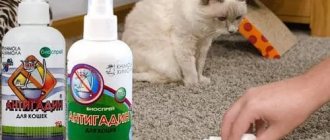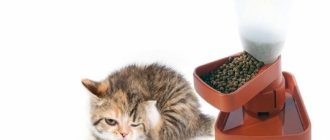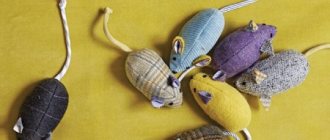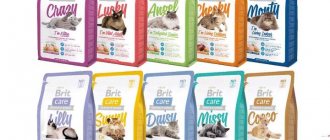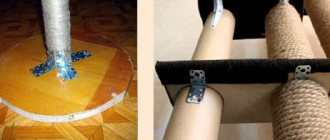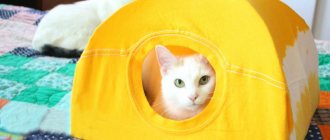It’s good when a cat owner thinks about nutritious nutrition for his pet. After all, the digestive process of cats is significantly different from the digestive process of humans. Only now the majority makes a choice in favor of industrial feed. Because they do not require time to prepare and their composition is balanced by specialists. That's right, but fresh homemade food is much healthier, and in case of health problems, it is certainly better to prepare food yourself, in consultation with a veterinarian.
Please note: this article offers only a few healthy and proven recipes, not a complete long-term menu.
What can cats do?
Before we figure out how to prepare a cat’s lunch, let’s find out which foods are considered acceptable and healthy for her. The cat will be healthy and cheerful if you feed it tasty and varied. For these pets, raw lean meat is suitable, such as lamb or beef, chicken, and lean ocean fish. It is also recommended to give boiled yolks or raw eggs and fermented milk products no more than twice a week.
It is strictly forbidden to feed cats chocolate, alcohol, avocados, nuts, grapes, yeast dough, onions, garlic and salt. These products are not only not required by the cat's body, but can also be harmful to it.
Features of preparing natural food for cats
Do-it-yourself natural, complete cat food is a rather labor-intensive product. In order for the body to receive all the necessary elements, it is necessary to consider:
- level of caloric needs (depending on activity and lifestyle);
- age, weight of the pet;
- presence of concomitant or chronic diseases;
- the cat's nutritional status;
- whether the animal is castrated, etc.
Essential Nutrients for Cats
- Taurine and arachidonic acid are found only in products of animal origin. These two components must be supplied to the cat’s body with food;
- iron (beef, lamb, buckwheat, apples, some types of greens);
- copper (shrimp, rice);
- zinc (beef, chicken hearts, cheese);
- manganese (liver, beets);
- calcium and phosphorus should be supplied in a ratio of 1-1.2: 1.
Approximate daily requirement for components
It is believed that a cat eats a portion of food per day, the volume of which is 3–7% of the animal’s weight. That is, if a cat weighs 4 kg, then during the day he should eat approximately 200 g of various ingredients.
Nutrient percentage recommendations:
- protein (animal origin) - 90–95%;
- plant foods - 5–10%;
- mineral fertilizing (if necessary).
How to choose a protein source?
It should be borne in mind that all types of meat (from the type of animal to parts of the carcass) differ in calorie content, crude protein content, fat content, and so on.
Animal protein may include:
- muscle meat - 70% (it is not always worth choosing dietary varieties, especially for kittens);
- by-products - 30%.
You can give your cat raw meat. The non-thermally processed product contains the largest amount of essential elements. Before purchasing, pay attention to the appearance of the meat; if necessary, the seller must provide a veterinary certificate stating that the product being sold has been tested and fully complies with all requirements.
Meat can also be frozen. It is more convenient to immediately divide it into portions and cut into small pieces. Before feeding, the product is thawed at room temperature.
One of the most accessible and closest to natural food sources for cats is quail, since purring pets tend to eat small birds, rodents and reptiles. The carcass can be fed whole or cut into pieces, adding some vegetables or bran - 2-3 times a week.
Important: remember that it is not recommended to give boiled bones, as they are difficult to digest and can cause intestinal blockage or injury.
Offal products include chicken hearts, beef tripe and lungs, chicken stomachs, and necks. The latter must be cut into pieces 1–2 cm long so that the animal does not choke. Necks contain calcium and are useful for removing deposits from your cat's teeth, but you shouldn't crush them too often. 1-2 times a week is enough. The liver deserves special mention. The liver of any type of animal is rich in microelements, but if fed excessively, an excess of vitamin A may occur. The safe amount of this by-product for a cat is 0.5 g per 1 kg of body weight per day. With retinol hypervitaminosis, cartilage tissue grows, which can eventually lead to pathologies of the musculoskeletal system. Also, excessive consumption of raw liver can make your cat weak.
What else can you give your cat on a natural diet?
Vegetables and herbs are the main source of carbohydrates and vitamins for cats; they are added in grated or finely chopped form:
- zucchini;
- cucumber;
- carrot;
- cauliflower;
- apple;
- greens without a strong taste;
- beet;
- pumpkin;
- broccoli.
Bran contains a lot of fiber, which improves intestinal prestalsis.
Additional supplements are selected based on the overall diet:
- Sunflower oil is a source of omega-3 and linoleic acids. For example, in olive oil their content is much lower;
- Fermented milk products (low-fat cottage cheese, unsweetened yogurt) are given with caution. The phosphorus content in these ingredients is higher than calcium, which is an incorrect ratio for the body. Also, large amounts of yogurt can create a laxative effect;
- Salmon or fish oil contains fat-soluble vitamins. But they are given when necessary, so as not to cause a toxic effect and an excessive dose of vitamin D;
- vitamin complexes are given in a course (1–2 times a year).
Advice: it is recommended to give fermented milk products separately from meat foods. Natural cat food recipes may include oil, and small amounts can also be added to meat.
Chicken and quail eggs are fed raw. They, like bran, go well with both meat and dairy products. A quail egg is given whole, but a chicken egg should be fed 1/4 part per day - 2-3 times a week.
Why is it better to cook for cats yourself?
Making your own cat food is not difficult at all. After all, although industrially produced food makes our lives much easier, they often contain ingredients that cannot be included in the diet of our pets. That is why every year there are more and more people who prefer a natural diet prepared in the home kitchen to commercially produced food.
Food specially prepared for a cat from healthy and fresh ingredients does not necessarily have to be the basis of his diet. You may be feeding him store-bought food more often, but it’s still worth making a healthy and enjoyable addition to your pet’s diet. And if you have enough free time, then the cat can be completely switched to food that you prepare yourself. It will be more natural than any food you can find in a pet store. But remember that you cannot simply feed your cat the same food that you yourself eat for dinner; these pets have dietary habits that must be observed. Therefore, you will have to cook for them separately.
What is better - buying or cooking?
Experts believe that everything depends on the capabilities of the owner and the preferences of the pet. Both options have their pros and cons.
Industrial feed is convenient - just open the package and measure out the desired portion. But it is difficult to fully understand their composition - it is not always indicated on the packaging, and it is simply impossible to check the quality of the ingredients.
You can choose products for natural nutrition yourself, but this requires the skills of both a nutritionist and a cook.
Natural food is better than industrial food if three conditions are met: the diet is balanced, the quality of the products is high and there is time to prepare food for the animal.
The main thing is protein
If you are wondering how to prepare food for your cat, then first of all focus on recipes that are rich in protein. There are quite a lot of them, including some simple ones that won’t take up much of your time, but will allow you to provide your pet with a healthy and balanced diet.
Of course, we should not forget that cats are very picky eaters. Therefore, you cannot guarantee that they will like your cooking; some types of food may not be to their taste. Remember, it is very important for cats that the dish smells delicious. You should never forget about this when deciding what to cook for your cat at home.
How to accustom a cat to new food
Cats quickly get used to a certain type of food, so they may initially refuse innovations. Continue to offer a new diet to your pet, sometimes replacing it with completely familiar food; over time, the animal will become interested in the product.
You can begin to introduce the ingredient, gradually adding it to the usual feeding, replacing it completely after 1-2 weeks.
Self-composition of a menu for cats begins if you are ready to correctly calculate the amount of necessary components and nutrients. If you are a busy person, travel or work a lot, who can provide proper care and nutrition for your little friend?
The animal needs not only boiled, but also raw or prepared food, which supplies the body with important substances, amino acids, which are destroyed during heat treatment. In this case, the best solution would be to feed with industrial feed that can provide all the vital components.
Recipe Features
In recipes for domestic cats, try to use a variety of meats; the more varieties, the better. It can be turkey, chicken, rabbit, beef, duck. This way you will be able to maximize the balance of nutrients, enriching the feeding with all sorts of different textures and tastes. It is best to use different sources of meat at the same time; cats will especially like this.
Can bones be used in cat food? The clear answer to this question is no. You should try to avoid them at all costs for fear of suffocation, blockage of the digestive tract or puncture, since cats' teeth are not as powerful as dogs' teeth to grind bones without endangering their health. Although cats themselves, as a rule, are not averse to gnawing on bones, fishing out all the pieces of meat that remain.
How to Prepare Chicken Heads
Most often, such products are sold in frozen packages. Wait for the heads to thaw. Then you need to rinse them with cool water, cut off the beaks (they are too tough for a cat), and cut them in half lengthwise. This will not require noticeable physical effort.
If the head is small and the pet is large, you don’t have to cut it - more nutrients will be retained in the product. Then the halves are put into portioned boxes or cups. You can use plastic cups with a volume of 200 ml, the same volume as sour cream and mayonnaise boxes. One such serving will last a medium-sized adult domestic cat for the whole day.
Healthy foods for cats
It is very useful to add the hearts of different animals to your cat's diet. After all, this is one of the main sources of taurine, which serves as an essential amino acid for this animal. If about ten percent of your pet's diet consists of hearts, for example chicken, then dietary supplements in the form of taurine are not needed, otherwise you cannot do without them.
It is also recommended to include the liver, spleen, and kidneys in the cat’s menu, which will also be very useful. True, most animals do not like the taste, but they can be disguised by mixing them with vegetables and meat, after chopping them. For vegetables, give preference to spinach, pumpkin, and carrots. Remember that garlic and onions are toxic to cats and should not be given to them.
How to feed your cat properly with natural food
A healthy diet includes proteins, fats, carbohydrates, vitamins and beneficial microelements. In addition, the new menu should appeal to cats, who are considered a finicky animal when it comes to nutrition. If she refuses, there is no need to insist.
Remember that food you prepare yourself is only suitable if the following rules are followed:
- there are many ingredients of animal origin in the pet’s diet;
- nutrition is balanced;
- Make sure your cat eats the entire portion;
- It is necessary to add vitamins and minerals essential for health to the diet, including calcium and phosphorus in a 2/1 ratio.
What do you need to prepare cat food?
To prepare a cat's dinner, you don't need any special equipment. In the kitchen you will need to have a food processor, blender, and meat grinder, because most products will have to be chopped. There is a basic formula for a cat's diet - half protein (mostly found in meat) and a quarter each of vegetables (they contain fiber) and carbohydrates (these are grains). A large amount of protein is found in chicken, turkey, rabbit and fish. The most optimal source of carbohydrates for animals is brown rice, and for vegetables you will have to rely on what your pet agrees to eat. In your diet, use both boiled and raw meat, mixing it with boiled vegetables and rice.
How to store?
It is recommended to store wet cat food in bags or containers. If we are talking about the latter, then they should not be too crowded. You need to leave 2 cm at the top, which will allow the product to expand when frozen. The cat owner will then need to mark the containers or bags. They indicate the type of meat and the date of preparation. You can also use glass jars, in which the prepared food is stored longer. However, it is important to pay attention to the fact that such jars should be intended not only for canning, but also for freezing.
When you need to feed your cat prepared food, you will need to remove it from the freezer and defrost it. Veterinarians do not recommend using a microwave oven for these purposes. To speed up the defrosting process a little, it is recommended to dip the container with the treat in hot water. Dry food is stored in a container for 2-3 months at a temperature of 25 degrees.
Source
Canned cat food
One of the most common cat foods is sold in canned form. Surely not everyone knows, but making canned food for cats with your own hands is quite possible, although you will have to face some difficulties. The fact is that the entire technological process will need to be followed so that bacteria do not appear in them, and besides, the meat must first undergo heat treatment. Such canned food must be prepared in glass jars with a capacity of 0.5 to one liter. They should be closed with tin lids. The jars are thoroughly washed and boiled beforehand.
The meat and broth that you will use must be placed in the jar hot, and at least two centimeters must be left between the canned food and the lid so that the jar does not “explode”. Once you have sealed the jar, it should be sterilized in a large saucepan, pressure cooker, or enclave at 115 to 120 degrees. This takes from one and a half to two hours. Please note that the jars should be immersed in already warm water. After cooking, canned fish and meat should be stored at a temperature of 10 to 15 degrees Celsius.
Is it possible to make food with your own hands?
Cooking at home is easy. However, homemade food made with your own hands will be different from food in bags that is made in a factory. Homemade dry and wet cat food is considered one of the methods to provide your pet with natural food for a long time. It is recommended to resort to recipes in situations where the cat is on natural feeding, and the owners do not have enough time to prepare food daily. Liquid cat food can be stored in the freezer for a long time, while dry cat food can be stored in containers.
Canned food recipes
Please note that most recipes are suitable for both preparing classic canned food and freezing. This is an alternative option that is suitable for those who do not want to spend a lot of time preparing jars and sterilizing them. The only difference will be that for classic canned food it is necessary to stew or boil all the products, and only then pour in the resulting broth, and for freezing they can be left raw.
So, the first recipe for making homemade canned food for your cat. Take any meat (it can be veal, beef, chicken, rabbit, salmon or turkey), cut it into small pieces and simmer in its own juice. Then pour this juice over the meat, and then put it in jars or freeze it.
Another recipe for canned cat will require bones, like jelly, if you are going to cook canned meat, or necks and heads if you decide to cook canned poultry. You should also have gelatin on hand. Make a steep broth from heads or bones, add gelatin at the rate of one gram per liter of water. Only after this, lower the meat into the broth. Then transfer it to a jar and fill it with broth.
We emphasize that this recipe is not suitable for freezing, because the resulting jelly will need to be immediately laid out in molds and fed to your pet. Here's how to prepare cat food at home.
Dear! give me a normal natural recipe for a cat for every day!!
For each animal, the composition of the diet is selected individually, based on its needs, period of life and health status. Your pet's menu should include four food groups: Meat; Dairy products and eggs; Fats and oils; Cereals, vegetables. Here are three universal recipes that every owner can use:
Beef meatballs “Nedelka”: Ingredients: Beef – 2 kg; Rice – 200 g; Frozen vegetables (carrots, broccoli, corn, bell pepper) – 400 g; Beef broth – 100 ml; Olive oil – 2 tablespoons. Preparation: Cut the beef into small pieces. Boil frozen or fresh vegetables and cool them. Boil and cool the rice. Grind all the ingredients in a meat grinder, adding beef broth and olive oil. Form portioned balls from the resulting minced meat. Place the finished meatballs in the freezer. Thaw as needed and give to your cat. The resulting quantity of meatballs is enough for an adult animal to feed for 7 days.
Ice cream for cats “Fuzzy”: This ice cream can be used as a summer treat and differs from regular “human” ice cream in the absence of ingredients harmful to cats (sugar, fat, dyes). Ingredients: Low-fat cottage cheese – 200 g; Kefir or fermented baked milk – 100 ml; Vanillin – 0.5 teaspoon. Preparation: Using a blender, mix all ingredients and pack into plastic cups. Insert a popsicle stick or plastic spoon into each cup. Place the ice cream in the refrigerator for 6 hours. Warm the finished portion a little in your palm so that the ice cream can easily separate from the walls. On a hot day, offer your pet a treat.
> But since meat contains a large amount of proteins, which are absorbed almost completely, to ensure good stool it is necessary to give cereals and fermented milk products.
Dry food
Dry food from the store is a favorite treat for many pets. However, really high-quality dry food, which contains all the necessary vitamins, nutrients and minerals, is very expensive. But manufacturers of cheap dry food often use low-quality ingredients, caring only about flavor enhancers, so that cats eat their products without getting practically anything useful.
But no one is stopping you from making dry cat food at home. It will be economical, tasty and safe for your pet’s health. To prepare it, take meat or offal; heart, liver, and chicken gizzards are perfect. As auxiliary ingredients you will need rice flour, oatmeal, vegetables, flour, fish oil, bran, vitamin and mineral supplements.
Power calculation
Natural food is convenient and allows you to control your pet’s weight, the amount of nutrients, mineral and vitamin supplements. But it requires the correct calculation of the daily norm, otherwise the animal will not avoid health problems in the future. For different ages, the amount of food is individual.
How much food is needed
From ten weeks the baby can be separated from its mother. Until he reaches the age of 9 months, he needs no more than 10% of his total body weight. For example, with a weight of 1.5 kg, a kitten needs 150 g of food. It can be meat, dairy products in a 50:50 ratio.
How much food does an adult need?
For a mature animal, the amount of food is prepared at the rate of 5% of the pet’s weight. With a cat weighing 4 kg, food needs 200 g, the composition is the same as for babies: equal shares of meat and dairy products. You can mix some vegetables (10-15 grams) and a couple of drops of vegetable oil into your food.
It is not always possible to weigh an adult cat separately. You can do the following: stand on a bathroom scale with your animal, then subtract your weight, which will leave you with the mass of your furry friend.
Cats should have constant access to clean filtered water; it is important that the liquid is always in sight. Furry pets, like all mammals, need it. Often cats prefer to drink from large, deep dishes: buckets, basins, ignoring small bowls.
A large dog bowl is an ideal container: the water will remain clean for a long time, and it will be difficult to turn the dish over. The cat regulates the amount of liquid needed on its own by drinking the required amount. You need to monitor older animals, because constipation may indicate an imbalance in water balance. To get rid of intestinal problems and prevent dehydration, cats are switched to feeding semi-liquid food.
Dry food recipes
Now we will tell you in detail how to prepare homemade cat food. For the first recipe take:
- kilogram of chicken liver;
- 300 grams of unsalted crackers;
- a large bunch of parsley.
Grind all ingredients as much as possible in a blender or meat grinder. Add a tablespoon of olive oil or fish oil and mix everything thoroughly. After this, place the resulting mass on a baking sheet previously covered with parchment, make a grid with a knife, it is along these lines that you will then break the food into pieces. Bake the food in the oven at 100 degrees for 20 minutes. When the mixture has cooled, divide it into pieces, then return to the oven and dry for another hour.
Another recipe for making delicious dry food for your cat.
You will need:
- 500 grams of beef liver, minced;
- 200 grams of wholemeal flour;
- a tablespoon of honey;
- a pinch of salt.
Mix all ingredients until the consistency of thick sour cream. Next, cook in the same way as in the previous recipe, only at an oven temperature of 150 degrees.
Many pets like this dry food recipe:
- 700 grams of beef liver, minced;
- a tablespoon of small oatmeal;
- two chicken eggs;
- a pinch of salt;
- a tablespoon of vegetable oil.
Mix everything thoroughly and cook as in the first recipe. Here's how to make your cat food she'll love.
Cooking steps
The ingredient composition is selected according to the recommendations of veterinarians. To make wet food, you need to follow the following algorithm:
- Buy meat. It is important that the meat product must be fresh and of high quality. It is better to buy from trusted sellers. Veterinarians do not recommend using ready-made minced meat.
- Process the meat. First of all, you will need to thoroughly wash your hands and then separate the meat from the bones. Next, you need to cut it into convenient slices and pass through a meat grinder.
- Prepare offal. Their number should not exceed 10% of the total feed volume. The products will also need to be put through a meat grinder and sent to the refrigerator.
- Prepare a suspension. To ensure that the finished food is as healthy as possible, it is recommended to add taurine, vitamins B and E, and egg yolks. These components will need to be poured with a small amount of water and mixed thoroughly.
- Mix the ingredients. In a convenient container you will need to combine the prepared meat, offal and suspension.
- Pack and place in the freezer.
Prepare delicious dry food like this:
- Prepare the ingredients. It is recommended to boil tough vegetables, freeze or cook meat.
- Pass the ingredients through a meat grinder.
- Mix meat and vegetables.
- Place the resulting mass on a baking sheet.
- Preheat the oven to 100 degrees and leave the dish in it for 90 minutes.
- Cut into small slices.
- Place in a convenient container with a lid or a bag that has a zipper.
Return to contents
Pros and cons of a natural nutrition system
Nothing in the world is completely positive or negative, and the “natural” cat has a number of advantages and disadvantages when it comes to feeding a cat.
+ You yourself control the quality and freshness of the products, you are always sure what products your cat eats.
— A varied menu for some regions can be quite expensive.
+ You can quickly identify and eliminate foods that cause allergic reactions in your pet.
— It takes much more time to prepare food for a cat than when feeding it dry.
— Cats may begin to be capricious and picky when they eat certain foods frequently.
+ You have the opportunity to control the weight and energy of your cat.
— Even with a balanced natural diet, cats require vitamin supplements.
— When a cat eats raw meat, the risk of infection with internal parasites and worms increases sharply.
— Difficulty in adjusting nutrition when your pet is sick.
+ Cats always eat meat and offal more readily than ready-made food.
+ The gastrointestinal tract always works better, because “natural” is closer to the cat’s body than “drying” for natural reasons.
+ Varied menu.
But the biggest difference between ready-made food and natural feeding is that dry food can be poured in large quantities at once for a whole day or even two. That is, you can go away for the weekend and not worry that the cat is hungry, but this will not work with natural food - the portion should be served only in the amount of a single dose and not just left in the room for more than an hour, as the food begins to dry out and spoil.
